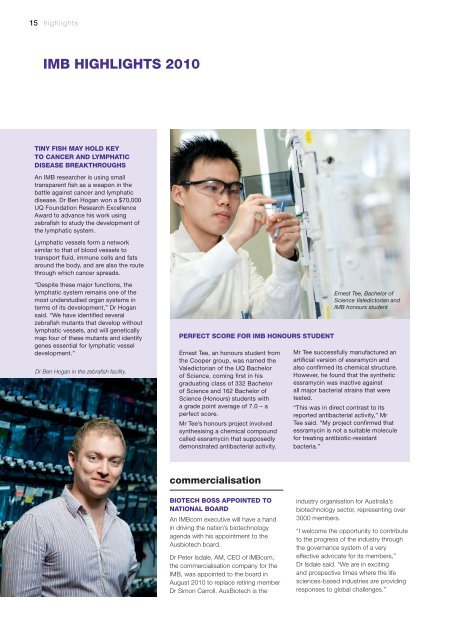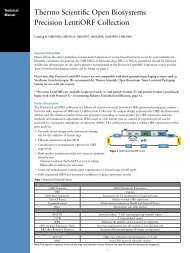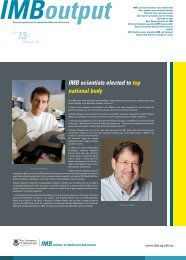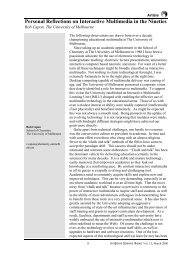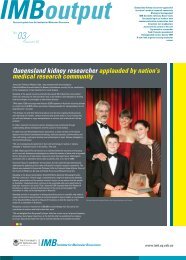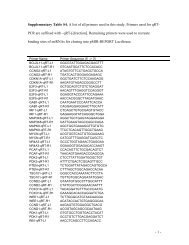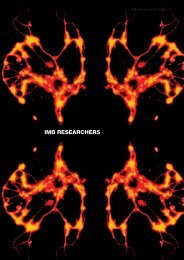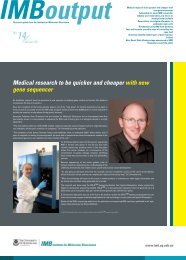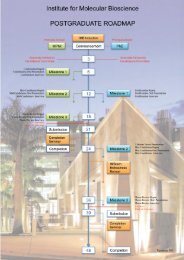2010 Annual Report - Institute for Molecular Bioscience - University ...
2010 Annual Report - Institute for Molecular Bioscience - University ...
2010 Annual Report - Institute for Molecular Bioscience - University ...
Create successful ePaper yourself
Turn your PDF publications into a flip-book with our unique Google optimized e-Paper software.
15 highlights<br />
IMB HIGHLIGHTS <strong>2010</strong><br />
TINY FISH MAY HOLD KEY<br />
TO CANCER AND LYMPHATIC<br />
DISEASE BREAKTHROUGHS<br />
An IMB researcher is using small<br />
transparent fish as a weapon in the<br />
battle against cancer and lymphatic<br />
disease. Dr Ben Hogan won a $70,000<br />
UQ Foundation Research Excellence<br />
Award to advance his work using<br />
zebrafish to study the development of<br />
the lymphatic system.<br />
Lymphatic vessels <strong>for</strong>m a network<br />
similar to that of blood vessels to<br />
transport fluid, immune cells and fats<br />
around the body, and are also the route<br />
through which cancer spreads.<br />
“Despite these major functions, the<br />
lymphatic system remains one of the<br />
most understudied organ systems in<br />
terms of its development,” Dr Hogan<br />
said. “We have identified several<br />
zebrafish mutants that develop without<br />
lymphatic vessels, and will genetically<br />
map four of these mutants and identify<br />
genes essential <strong>for</strong> lymphatic vessel<br />
development.”<br />
Dr Ben Hogan in the zebrafish facility.<br />
PERFECT SCORE FOR IMB HONOURS STUDENT<br />
Ernest Tee, an honours student from<br />
the Cooper group, was named the<br />
Valedictorian of the UQ Bachelor<br />
of Science, coming first in his<br />
graduating class of 332 Bachelor<br />
of Science and 162 Bachelor of<br />
Science (Honours) students with<br />
a grade point average of 7.0 – a<br />
perfect score.<br />
Mr Tee’s honours project involved<br />
synthesising a chemical compound<br />
called essramycin that supposedly<br />
demonstrated antibacterial activity.<br />
Ernest Tee, Bachelor of<br />
Science Valedictorian and<br />
IMB honours student<br />
Mr Tee successfully manufactured an<br />
artificial version of essramycin and<br />
also confirmed its chemical structure.<br />
However, he found that the synthetic<br />
essramycin was inactive against<br />
all major bacterial strains that were<br />
tested.<br />
“This was in direct contrast to its<br />
reported antibacterial activity,” Mr<br />
Tee said. “My project confirmed that<br />
essramycin is not a suitable molecule<br />
<strong>for</strong> treating antibiotic-resistant<br />
bacteria.”<br />
commercialisation<br />
BIOTECH BOSS APPOINTED TO<br />
NATIONAL BOARD<br />
An IMBcom executive will have a hand<br />
in driving the nation’s biotechnology<br />
agenda with his appointment to the<br />
Ausbiotech board.<br />
Dr Peter Isdale, AM, CEO of IMBcom,<br />
the commercialisation company <strong>for</strong> the<br />
IMB, was appointed to the board in<br />
August <strong>2010</strong> to replace retiring member<br />
Dr Simon Carroll. AusBiotech is the<br />
industry organisation <strong>for</strong> Australia’s<br />
biotechnology sector, representing over<br />
3000 members.<br />
“I welcome the opportunity to contribute<br />
to the progress of the industry through<br />
the governance system of a very<br />
effective advocate <strong>for</strong> its members,”<br />
Dr Isdale said. “We are in exciting<br />
and prospective times where the life<br />
sciences-based industries are providing<br />
responses to global challenges.”


